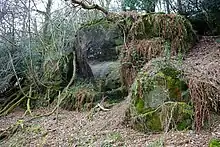Wakehurst and Chiddingly Woods
Wakehurst and Chiddingly Woods is a 155.9-hectare (385-acre) biological and geological Site of Special Scientific Interest south-east of Crawley in West Sussex, England.[1][2] It is a Nature Conservation Review site, Grade I,[3] and part of it is a Geological Conservation Review site.[4]
| Site of Special Scientific Interest | |
 Sandstone crag in Tilgate Wood | |
| Area of Search | West Sussex |
|---|---|
| Grid reference | TQ 336 321[1] |
| Interest | Biological Geological |
| Area | 155.9 hectares (385 acres)[1] |
| Notification | 1987[1] |
| Location map | Magic Map |
These woods have steep sided valleys formed by streams cutting through Wadhurst Clay and Tunbridge Wells sands, exposing outcrops of sandstone. The valleys have a warm, moist micro-climate, with a rich variety of ferns, mosses, liverworts and lichens. There is a diverse breeding bird community. Chiddingly Wood is geologically important because weathering of its sandstone has produced sculptured blocks and a comprehensive set of micro-weathering features.[5]
References
- "Designated Sites View: Wakehurst and Chiddingly Woods". Sites of Special Scientific Interest. Natural England. Retrieved 23 May 2019.
- "Map of Wakehurst and Chiddingly Woods". Sites of Special Scientific Interest. Natural England. Retrieved 23 May 2019.
- Ratcliffe, Derek, ed. (1977). A Nature Conservation Review. 2. Cambridge, UK: Cambridge University Press. p. 48. ISBN 0521 21403 3.
- "Chiddingly Wood (Quaternary of South-East England)". Geological Conservation Review. Joint Nature Conservation Committee. Retrieved 6 April 2019.
- "Wakehurst and Chiddingly Woods citation" (PDF). Sites of Special Scientific Interest. Natural England. Retrieved 23 May 2019.
| Wikimedia Commons has media related to Wakehurst and Chiddingly Woods. |
This article is issued from Wikipedia. The text is licensed under Creative Commons - Attribution - Sharealike. Additional terms may apply for the media files.